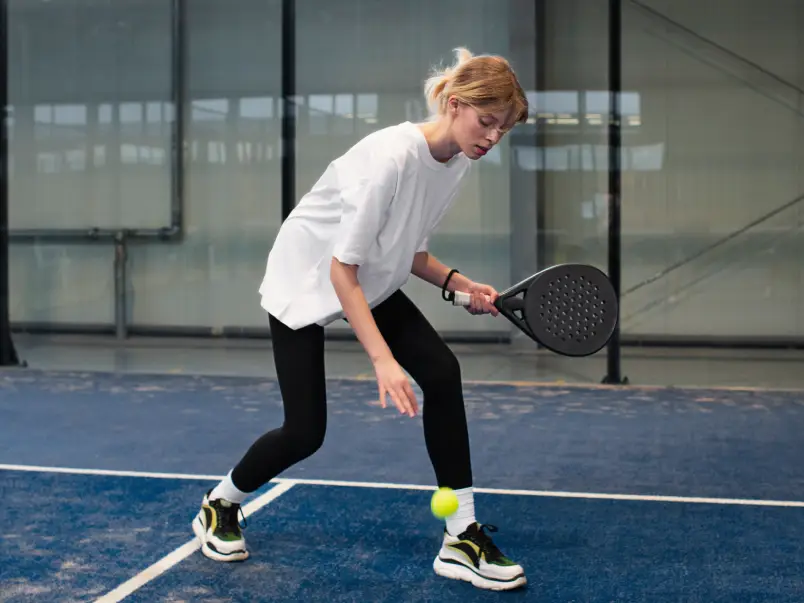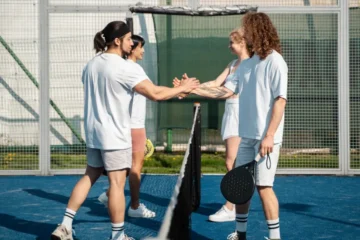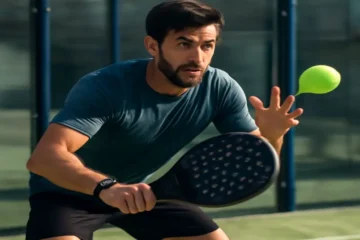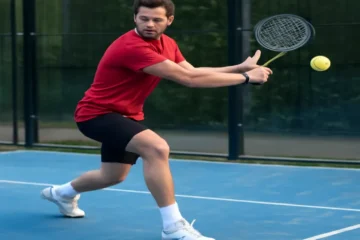Padel is an exhilarating, fast-paced sport that demands skill, agility, and sharp strategy. For left-handed players, stepping onto the padel court often feels like a challenge. The sport seems designed for right-handed athletes, with most players conditioned to face off against their right-handed opponents. But here’s the good news for left-handers: Your left-handedness isn’t a hindrance—it’s an advantage.
Imagine being in the middle of a match, your opponent feeling uncertain and slightly off-balance, trying to adjust to your angles and movements. For most left-handed players, this scenario is a regular experience. If you’ve ever felt awkward or unsure about your place on the court, you’re not alone. But once you embrace your unique advantages, your left hand can become a powerful tool that’s hard to defend against.
In this guide, we’ll explore how to make the most of your left-handedness in padel, turning what some may see as a disadvantage into your greatest asset. From positioning to shot selection and strategic tips, this guide will empower you to dominate the court and make your left-handed game unstoppable.
1. The Left-Hander’s Advantage: Why You’re Naturally Dangerous
The Element of Surprise
One of the most powerful aspects of being a left-handed padel player is the element of surprise. The majority of padel players are right-handed, so most opponents are conditioned to anticipate right-handed shots. When you step onto the court with your left hand, you disrupt the familiar flow of the game. The angles you create, both on your forehand and backhand, are unnatural to most right-handed players, making it more difficult for them to return shots effectively.
Dominating the “Golden Side” (Right Side of the Court)
In padel, the right side of the court is often referred to as the “golden side.” This side offers significant advantages for right-handed players, as their forehand naturally covers the middle of the court. However, for left-handed players, the right side becomes an even greater advantage. Here’s why:
- Your Forehand is in the Center: As a left-handed player, your forehand naturally covers the middle of the court. This means you can execute powerful, aggressive shots down the center of the court, where opponents are most vulnerable. The “3-meter wall” rule (the wall that limits players’ movement to within three meters of the net) works in your favor, allowing you to dictate the flow of the rally.
- The Devastating Bandeja/Smash: A left-handed player’s angle for a bandeja or smash from the right side of the court is also a powerful weapon. It naturally targets the opponent’s backhand corner—the weakest shot for most right-handed players. This creates opportunities for you to attack and pressure your opponent in ways that can result in easy points.
- The “Out” Angle: A left-handed player’s backhand down the line from the right side creates sharp angles that are very difficult for opponents to retrieve. By hitting the ball at a steep angle, you can force your opponent to scramble and make mistakes, creating more opportunities to win points.
2. Foundational Setup: Positioning and Partnership
Where Should You Stand? The Great Debate
The key to unlocking your left-handed advantage lies in your positioning on the court. While many left-handed players naturally gravitate toward the left side, there are two main positioning options to consider:
- Option A: The Right Side (The Conventional Choice): The most common position for left-handed players is the right side of the court. This is where your advantages are maximized. With your forehand in the middle of the court, you can take control of rallies and execute powerful smashes with ease. Your positioning also makes it easier to exploit the opponent’s weaknesses by targeting their backhand corner.
- Option B: The Left Side (The Unconventional Powerhouse): While less common, playing on the left side can also be highly effective. This setup creates two forehands in the middle of the court, adding pressure with continuous offensive shots. However, this approach requires excellent communication with your partner and precise footwork to avoid confusion. It can be an effective tactical switch when you want to surprise your opponents.
Communication is Key: Talking to Your Partner
When playing doubles, communication with your partner is essential. You need to clearly decide who will take the middle ball and discuss positioning for lobs and who will cover each angle. Your partner must understand your natural shot angles and anticipate your movements. Without good communication, even the most powerful left-handed shots can become a disadvantage.
3. Mastering Your Arsenal: Left-Handed Shot Selection
The Serve:
As a left-handed player, your serve can be one of your strongest weapons. The natural slice of your serve pulls your right-handed opponent wide off the court, creating space for your next shot. By serving wide to the backhand side, you force your opponent into a defensive position right from the start of the point.
The Forehand: Your Weapon of Mass Destruction
Your forehand is one of the most dangerous aspects of your game. From the right side, you should focus on:
- Powerful shots to the backhand side: The majority of right-handed players struggle with their backhand, so attacking this side with your forehand creates a huge advantage.
- Aggressive “winner” shots: Your forehand should be used to take control of rallies. Hitting deep, powerful shots down the center of the court can force your opponent into a defensive position, where they have fewer options for return.
Using the Glass: When you’re on the right side of the court, using the side glass to your advantage is crucial. A forehand off the side glass can be a primary building shot, allowing you to generate angles and force your opponent into awkward positions.
The Backhand: Creating Deceptive Angles
Although the left-handed backhand can sometimes be weaker than the forehand, with practice, it can become an effective weapon. From the right side, your backhand down the line can create sharp, offensive angles that catch opponents off guard. Focus on hitting the ball with precision to make your backhand an unpredictable shot.
The Vibora/Bandeja: This is Where You Shine
One of the biggest advantages of being a left-handed player in padel is your natural angle for the vibora (a slicing shot) or bandeja (a defensive overhead shot). From the right side of the court, these shots will force your opponent into uncomfortable, defensive positions, often leading to a weak return. Practice your vibora and bandeja to perfection to maximize your advantage.
The Smash:
A smash from the right side of the court naturally targets your opponent’s backhand corner. By mixing power with angles, you can keep your opponent guessing and create easy points. Remember to vary the speed and direction of your smashes to prevent your opponent from anticipating your next move.
4. Advanced Tactics and Gameplay Strategies
Exploiting the Right-Hander’s Weakness
The key to success as a left-handed player lies in consistently targeting your opponent’s backhand (their left side). This is especially crucial during crucial points, as right-handed players often struggle with their backhand under pressure. By constantly attacking their weakest shot, you’ll force mistakes and gain the upper hand in rallies.
The “Two Forehands in the Middle” Strategy
When playing with a right-handed partner, one of the most effective strategies is the “two forehands in the middle” setup. This formation puts constant pressure on your opponent with powerful forehands through the center of the court, making it difficult for them to adjust. Communication and positioning are key to executing this strategy successfully.
Doubles Team Formations
- Left-Hander + Right-Hander: The most balanced and effective pairing, with each player covering a different side of the court. This combination allows you to exploit both your forehand and your partner’s strengths.
- Two Left-Handers: A rare but powerful combination, two left-handed players can overwhelm their opponents with unfamiliar angles. This pairing requires excellent communication, but when executed well, it can flip the conventional game dynamics on its head.
5. Common Pitfalls and How to Avoid Them
Over-relying on Power: While it’s tempting to rely on your natural power, focusing solely on hitting hard can be detrimental. Instead, focus on shot placement and using your natural angles to create opportunities for precision shots.
Neglecting Your Backhand: Many left-handed players neglect their backhand, but this can be a mistake. A weak backhand can easily be exploited by your opponent. Make sure to spend time practicing your backhand to ensure it’s a solid part of your arsenal.
Poor Communication: In doubles, poor communication is the number one reason left-handed/right-handed teams lose. Make sure you communicate clearly with your partner about positioning and shot selection to avoid confusion.
Conclusion: Embrace Your Uniqueness
Your left-handedness is not just a quirk—it’s a strategic advantage that, when leveraged correctly, can make you a dominant force on the padel court. By mastering your positioning, utilizing your powerful forehand, and creating deceptive angles, you can turn your left-handed game into an unstoppable weapon.
So, the next time you step onto the padel court, don’t try to play like a right-hander. Embrace your left-handedness, fine-tune your specific shots, and communicate effectively with your partner. With these tools at your disposal, you’ll be well on your way to dominating the game and leaving your right-handed opponents struggling to keep up.
FAQs
What are the advantages of being a left-handed player in padel ?
Being left-handed in padel gives you a natural advantage by creating angles that right-handed players are not used to. Your forehand naturally covers the center of the court, and your backhand down the line creates sharp, difficult-to-return shots. Left-handed players can also exploit their opponent’s backhand, their weakest side, particularly with powerful smashes and bandejas.
Where should a left-handed player stand on the padel court ?
Left-handed players have two main options for positioning: the right side and the left side. The right side is the conventional choice, where your forehand covers the center of the court and your smashes target the opponent’s backhand. However, playing on the left side can be a surprise tactic, creating two forehands in the middle of the court, but it requires good communication with your partner.
How can I improve my left-handed backhand in padel ?
While the backhand is typically weaker for left-handed players, practicing precision and using it to create sharp, offensive angles can make it a potent weapon. Focus on hitting down the line to surprise your opponent and make the most of the natural angle your backhand provides.
What is the best strategy for left-handed doubles teams ?
The most common and effective doubles formation for a left-handed player is pairing with a right-handed player. This allows each player to cover different sides of the court while maximizing their strengths. A left-handed-left-handed pairing is rare but can be highly effective when executed with clear communication and coordination.
How can I use my left-handed serve to my advantage ?
As a left-handed player, your serve is a powerful weapon. Using a natural slice, you can pull your right-handed opponent wide off the court, creating space for your next shot. Aim for your opponent’s backhand side to put them on the defensive from the start.




